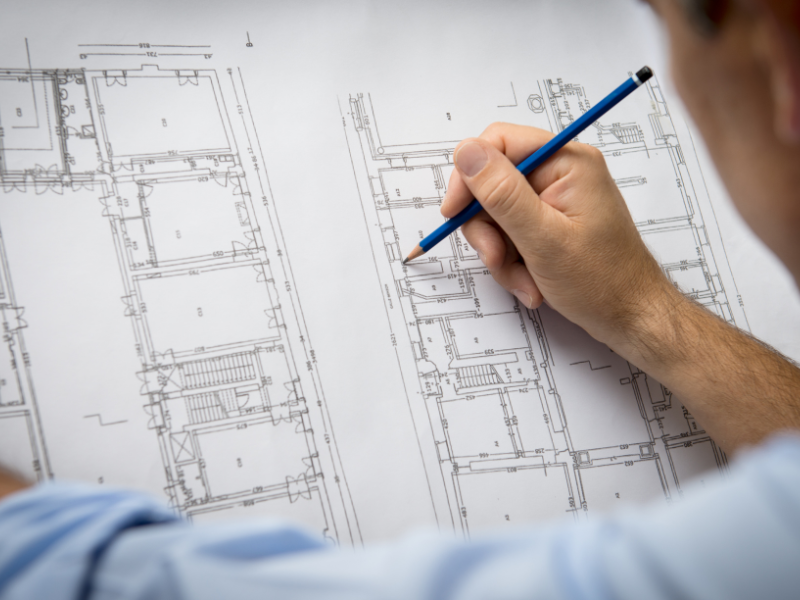Architect Collaboration Tips for Working with Contractors and Builders
Architect Collaboration Tips for Working with Contractors and Builders
Blog Article
Understanding the Diverse Occupation Paths Available for Aspiring Architect
As an ambitious Architect, you have a world of profession paths waiting on you. Each path offers special obstacles and opportunities to apply your imagination and technological expertise. Whether you're attracted to conventional architecture or the nuances of sustainable design, there's a particular niche that straightens with your interests. Comprehending these diverse options can shape your specialist journey, however which direction will you choose to check out first?
Standard Architecture: Creating Buildings and Structures
Typical style concentrates on making structures and frameworks that mix performance with aesthetic appeal. As you discover this area, you'll value the intricate balance in between kind and purpose. You'll find out to attract ideas from historic styles, incorporating components like balance, materials, and workmanship. Your styles can reflect cultural heritage, showcasing regional practices while satisfying modern-day needs.
You'll create skills in drafting, model-making, and site analysis, permitting you to envision and connect your concepts effectively. Engaging with customers, you'll require to understand their vision and convert it into possible styles.
Additionally, developing codes and sustainability methods are vital in your work, guaranteeing your structures are safe and environmentally pleasant. As you expand in your occupation, you'll discover possibilities in domestic, business, or perhaps reconstruction projects, each offering special obstacles. Accepting traditional design leads the way for a meeting job that admires the past while forming the future.
Urban Preparation: Shaping Communities and Public Spaces
As an ambitious Architect, you can play a crucial duty as a metropolitan coordinator, transforming exactly how neighborhoods interact and work. By using community engagement techniques, you'll assure that residents have a voice in shaping their setting. And also, incorporating lasting design principles will certainly aid create spaces that not just meet today's requirements however additionally shield the future.
Function of Urban Planners
While lots of could believe of engineers as the single dreamers behind structures, metropolitan planners play a necessary function in forming the broader landscape of neighborhoods and public spaces. By teaming up with various stakeholders, you'll help develop parks, transport systems, and residential areas that advertise social communication and access. Your proficiency in spatial layout and neighborhood dynamics permits you to visualize future development while protecting social heritage.
Neighborhood Involvement Approaches
Efficient area engagement strategies are important for metropolitan planners to ensure that the voices of residents are listened to and valued in the preparation process. To cultivate meaningful discussion, you must focus on open forums and workshops where area members can reveal their concepts and problems. Usage surveys and social media sites to get to a more comprehensive audience, making sure varied point of views are consisted of. Teaming up with regional organizations can enhance depend on and help with deeper connections. It is necessary to offer clear information concerning suggested projects and decision-making procedures, enabling locals to really feel enlightened and empowered. By actively integrating and paying attention feedback, you'll produce rooms that reflect the community's requirements, eventually resulting in more sustainable and successful metropolitan settings. Welcome transparency and continual dialogue for lasting influence.
Lasting Layout Concepts
When creating urban spaces, including sustainable layout principles is important for developing settings that grow both ecologically and socially. Consider incorporating environment-friendly areas, like gardens and parks, to enhance biodiversity and enhance air quality.
Designing with water conservation in mind is additionally key-- consider rainfall gardens and absorptive surface areas to handle stormwater. Involving area participants throughout the planning process assurances that the areas you develop satisfy their demands and urge social communication. By accepting these concepts, you'll add to vibrant, lasting metropolitan landscapes that profit everybody.

Landscape Design: Developing Sustainable Exterior Environments
As you check out landscape architecture, you'll discover vital style concepts that produce lovely and useful exterior rooms. Lasting methods play a crucial function in making certain these atmospheres thrive while reducing environmental impact. And also, you'll find a variety of career possibilities that allow you to make a real difference in how individuals interact with nature.
Layout Principles in Landscape
Understanding layout concepts in landscape style is essential for creating lasting outside atmospheres that balance with nature. You'll require to ponder aspects like balance, proportion, and range to ensure your styles feel cohesive and inviting. In addition, pay interest to seasonal modifications, developing with materials that enhance the surroundings year-round.
Sustainable Practices Overview
Sustainable practices in landscape design not just concentrate on aesthetic appeals but additionally prioritize eco-friendly health and resource conservation. By integrating native plants, you boost biodiversity and lower the need for chemical plant foods and pesticides. Implementing reliable irrigation systems helps save water and decreases overflow, shielding close-by communities. You can make areas that advertise soil wellness, such as using organic products and practicing permaculture principles. Additionally, including green facilities, like rainfall gardens and porous pavements, help in stormwater management and decreases urban warm. You contribute to a much healthier planet and provide spaces that promote area connection when you create outside environments with sustainability in mind. Eventually, these methods ensure your designs benefit both people and the atmosphere for many years to find.
Job Opportunities Exploration
With a strong structure in sustainable techniques, landscape architecture offers a selection of job paths that permit you to make a purposeful effect on the setting. You could function as a landscape developer, producing cosmetically pleasing and functional exterior areas, or specialize in eco-friendly reconstruction, helping to revive broken ecological communities. Urban organizers often work together with landscape designers to produce environment-friendly spaces in metropolitan settings, improving city livability. If you're passionate regarding education, think about coming to be a landscape design educator, inspiring future generations. In addition, you may work with nonprofits concentrated on environmental sustainability or engage in study to innovate new techniques. Each course not only shapes lovely settings but additionally cultivates a healthier world for future generations.
Lasting Style: Focusing on Eco-Friendly Practices
As you discover your profession in architecture, welcoming eco-friendly practices can set you apart in an affordable field. Lasting layout focuses on creating buildings that lessen environmental influence while boosting occupant wellness. By incorporating eco-friendly products, energy-efficient systems, and lasting building methods, you'll contribute to a greener future.
Beginning by gaining knowledge of green certifications like LEED or BREEAM, which web link can reinforce your credentials. Think about just how natural light, ventilation, and thermal efficiency can maximize layout. Collaborate with designers and environmental professionals to innovate options that minimize waste and conserve resources.
Don't neglect the significance of area participation-- engaging local stakeholders can inspire designs that balance with the setting. As customers significantly prioritize sustainability, your proficiency in eco-friendly practices will not just draw in projects yet likewise accomplish your passion for liable design. Accept this important facet of the profession, and enjoy your profession thrive.
Historic Conservation: Shielding and Recovering Social Heritage
While you commence on your building journey, take into consideration the vital role of historic preservation in keeping our cultural heritage. This field concentrates on the security and reconstruction of significant structures, sites, and structures that inform the tales of our past. By involving in historical preservation, you'll assist protect the architectural legacy that forms neighborhood identification.
As a historical preservation Architect, you'll evaluate historical value and examine the condition of structures. You'll function carefully with historians and conservationists to guarantee authentic remediation methods are employed. This career course permits you to mix creativity with research, enabling you to create options that respect original products and craftsmanship.
Your job not only adds to sustainability by recycling existing structures yet also promotes a sense of pride within neighborhoods. Embracing this course will certainly help you become a guardian of background, protecting the stories and looks that improve our lives.
Interior Design: Enhancing Indoor Spaces
Historic conservation and indoor architecture both share a dedication to boosting the developed atmosphere, yet they focus on various facets. While historical preservation emphasizes keeping a structure's historical and cultural value, indoor design nos in on maximizing indoor rooms for performance and aesthetic appeals.
As a hopeful Architect, you'll find that interior style allows you to blend imagination with technological abilities. You'll create areas that not only look good yet additionally advertise comfort and performance. This field includes recognizing how light, color, and products engage within a space, impacting Continue mood and use.
You'll work on numerous projects, from property homes to commercial workplaces, guaranteeing that each atmosphere fulfills the demands of its residents. By prioritizing individual experience, you can transform insides into inspiring and useful areas, making a significant effect on how people engage with their environments. Welcome the opportunity to enhance indoor settings and form the means individuals live and function.
Industrial Style: Combining Capability With Aesthetics
Commercial layout plays a necessary duty in producing products that seamlessly blend visual appeals with capability, guaranteeing that what you use day-to-day is not only aesthetically attractive but additionally sensible. As a hopeful Architect, you could engage yourself in this area, focusing on designing every little thing from furniture to customer electronics. Your work entails recognizing customer requirements, products, and producing procedures, enabling you to develop cutting-edge remedies that boost day-to-day experiences.
In commercial style, you'll often collaborate with suppliers, marketing professionals, and engineers, ensuring that your layouts are not just lovely but likewise possible. This career course provides a vibrant atmosphere where creative thinking satisfies functionality, making it a fulfilling choice for architects interested in forming the items of tomorrow.
Frequently Asked Questions
What Educational Certifications Do I Need to End Up Being a Designer?
To come to be a designer, you'll require a professional degree in design, commonly a Bachelor's or Master's. In addition, you'll need to complete a teaching fellowship and pass the Architect Enrollment Exam to practice legally.
Exist Certification Needs for Different Building Job Paths?
Yes, there're certification needs for different architectural paths. Architect. You'll require to pass tests, total internships, and often go after specialized training, relying on your chosen focus, like landscape style, metropolitan design, or historic preservation
What Software Program Skills Are Necessary for Engineers Today?

How Can I Gain Practical Experience While Studying Architecture?
You can get sensible experience by interning at architectural companies, joining layout competitors, offering for community projects, or working together with classmates on real-world assignments. These opportunities boost your skills and build useful links in the market.
What Work Opportunities Exist Outdoors Typical Architecture Firms?
You can discover various task possibilities outside traditional architecture companies, like urban preparation, indoor style, landscape design, construction management, property growth, or perhaps functions in sustainability consulting. Each deals distinct challenges and benefits.
Whether you're attracted to traditional architecture or the subtleties of sustainable style, there's a niche that lines up with your interests.When developing metropolitan rooms, incorporating lasting design concepts is vital for creating environments that thrive both ecologically and socially.As you explore landscape style, you'll discover essential style principles that produce lovely and useful exterior spaces.Understanding design principles in landscape architecture is important for creating sustainable outside environments that balance with nature.In industrial layout, you'll typically collaborate with marketers, manufacturers, and designers, guaranteeing that your designs are not just stunning yet also feasible.
Report this page